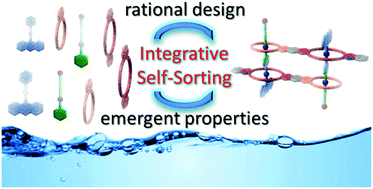Integrative self-sorting: a versatile strategy for the construction of complex supramolecular architecture
Abstract
Large protein-sized synthetic supramolecular architecture is rare and certainly has not yet achieved the structural and functional complexity of biomolecules. As multiple, identical copies of a few building blocks are repetitively used, a highly symmetrical architecture results with limitations in function. In marked contrast, functional structures in nature are often assembled with high geometric precision from many different building blocks. They cooperate in a complex way realizing energy conversion, mechanical motion or transport phenomena. Beyond self-assembly, the structurally and functionally complex biomolecular machines rely on self-sorting to correctly position all subunits through orthogonal recognition sites. Mimicking such self-sorting processes is a promising strategy for supramolecular synthesis – resulting in higher structural complexity and promising access to a more sophisticated function. The term “integrative self-sorting” was coined to describe the strategy to form well-defined assemblies with well-controlled subunit positions. The key process is the incorporation of two or more orthogonal binding motifs into at least some of the subunits. Modularity and programmability based on orthogonal yet similar binding motifs generate diversity and complexity. Integrative self-sorting is thus inherently related to systems chemistry. Depending on the individual binding motifs, (multi-)stimuli responsiveness can be achieved. When different recognition events en route to the final assembly occur on significantly different time scales, kinetic pathway selection is observed. In this account, we review the modularity, programmability, and emergent properties of integrative self-sorting, emphasizing its utility and perspective for complex supramolecular architectures.


 Please wait while we load your content...
Please wait while we load your content...